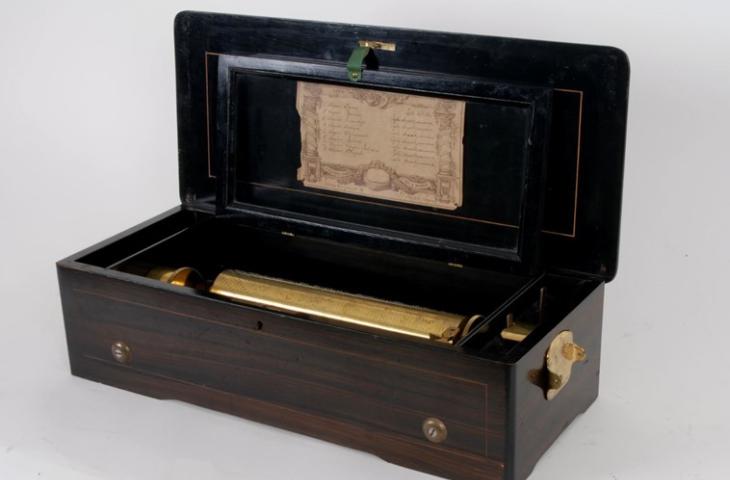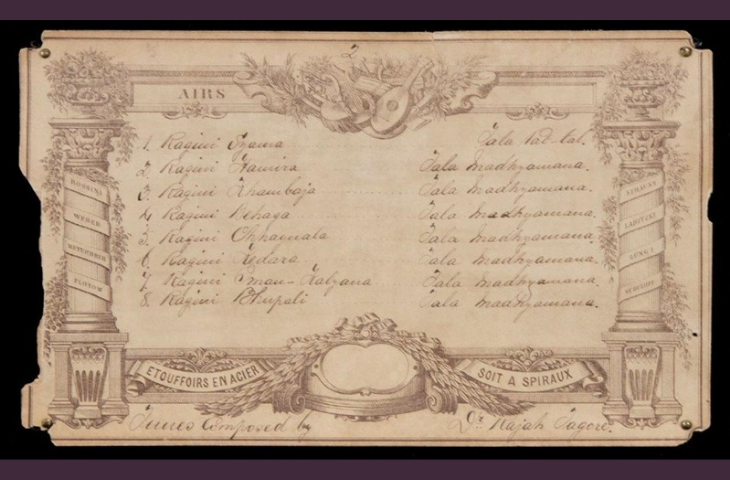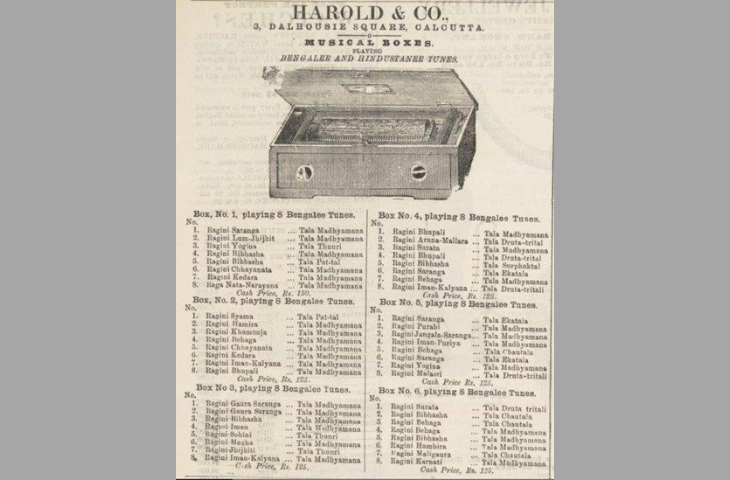March 2023
Fig.1

Music box with cylinder, Paillard-Vaucher, Switzerland, around 1880, inv. 1946
Fig.2

Music box label inv. 1946
Fig.3

Advertisement by Harold & Co, Sunday Mirror, Calcutta, 1881
The music box with cylinder of the MIM
Between its creation in 1877 and the mid-1960s, the MIM (successor to the Instrumental Museum) had only one music box in its collection (fig. 1). It was entered in the inventory under the number 1946 in the last years of the 19th century (Catalogue, vol. 3, 1900) and was sent in 1881 by the rajah Sourindro Mohun Tagore to King Leopold II, who in turn passed it on to the Brussels museum. This music box thus followed a similar path to that of the 98 Bengali instruments already sent by Tagore and which, in 1876–1877, had prompted Victor-Charles Mahillon to create the Instrumental Museum.
The reception of the music box in Brussels
One may wonder about Mahillon's lack of interest in an instrument whose mechanisms and applications are nonetheless varied: snuffboxes, watches, cartels, cylinders, records, etc. It is all the more intriguing that music boxes, with their metal blades arranged in a comb and set in vibration by a studded cylinder linked to a spring mechanism, are the only representatives of the category of "autophonic pinched instruments with automatic movement" (class I, branch B, section c), theorized by Mahillon himself in his famous instrumental classification.
It is true that Victor-Charles Mahillon considered "pinched autophones" to be "few and unimportant" instruments (Catalogue, vol. 1, 1880). His secretary, Ernest Closson, placed music boxes in the category of "fancy organology" or "musical toys" (Guide musical no 7, 1902). However, behind the reception of the music box inv. 1946, one can detect a particular value conferred on this instrument. The Descriptive and Analytical Catalogue of the Instrumental Museum shows the perception the museum’s first curator had of this music box: "This instrument plays eight tunes composed by the donor in order to give us an exact idea of the music of his country" (Catalogue, vol. 3, 1900).
The music box as a recording device
Thus, although linked to the development of Swiss watchmaking at the end of the eighteenth century, which enabled the development of precision mechanics, this fundamentally European instrument was nonetheless experienced as a means of "photographing," of "giving an exact idea" of a distant musical tradition, which had previously been accessible only through the "cold interpretation of notation." Mahillon perceived the inv. 1946 music box as a tool capable of objectively recording music. Indeed, Edison’s phonograph was still in its infancy and music reproduction would long remain the prerogative of music boxes. However, at the very moment the third volume of the Catalogue appeared, in which Mahillon described Tagore’s music box as a kind of recorder, he received from the same Tagore, still in Calcutta, a batch of “five cylinders [for phonograph] reproducing Hindu music” (Annuaire du Conservatoire, 1900, p. 100).
The Helvetic-Indian origin
Although the music box cylinder ‘records’ melodies composed by a renowned musicologist in Calcutta, the music box was clearly not made there. Despite the absence of a name, brand, or serial number, the list of composers in two columns on its label ('Rossini, Weber, Meyerbeer, Flotow' on the left, and 'Strauss, Labitzky, Gung'l, Schulhof' on the right) points directly to the Swiss manufacturers Paillard-Vaucher (brothers or sons?), active in Sainte-Croix from the last quarter of the 19th century (First Austrian Music Box Society, Erforschungs-Initiative Österreichische Uhrenspielwerke, https://www.eiou.at). Furthermore, the presence of a mandolin cylinder - a device for playing a fast tremolo - on the instrument makes it possible to identify, especially in public sales, several other instruments produced by the same firm, but playing more classically European compositions.
While it may seem surprising that an instrument made in Switzerland should have reached Brussels via Bengal, this tortuous path is easy to explain. From the early 1880s onwards, the music retailer Harold & Co, one of the leading distributors of European music in the British Raj, began marketing six models of music boxes in Calcutta, each playing eight different Bengali tunes. A comparison of the advertisements published by the dealer in the Indian press and the label of the music box offered by Tagore leaves no doubt that the instrument kept at the MIM corresponds to number 2 in the Harold & Co catalogue. Moreover, the handwritten number on its printed label proves that the attribution of the ‘Bengali tunes’ to Tagore was made in Calcutta in the retailer’s shop. It must therefore be concluded that after an order from Harold & Co to Paillard-Vaucher, the music box was sent from Switzerland to India with a blank label where it was completed before being distributed to the Bengali market (fig. 2).
Commercial product and cultural reflection
It was therefore not an instrument designed for the European market that Tagore had sent to Leopold II, and even less an instrument intended to render ‘the sentiment of the author himself’ to Mahillon’s ears. On the contrary, given that Harold & Co in Calcutta was the main distributor of musical instruments for British settlers, including pianos, one can legitimately assume that the six Swiss-made music boxes playing Bengali tunes were primarily commercial products for the same audience (fig. 3). Moreover, in the context of a sharp devaluation of Indian silver currency against the rising British pound, the catalogue price of 125 rupees suggests these imported items were rather luxury goods (John Adams and Robert Craig West, "Money, Prices, and Economic Development in India, 1861–1895," The Journal of Economic History, vol. 39, no. 1, 1979).
Thus, the 1946 music box is not what Mahillon thought. The settlement of Europeans in the British Raj gave rise to a new market characterized, in particular, by demand for luxury goods that in some way reflected but were necessarily distinct from local culture. In response to this demand, new local interactions took place - in this case, Tagore’s composition of tunes for Harold & Co for the import of music boxes from Switzerland. Designed for distribution among British colonists, they were only exported to Europe following the rajah’s initiative. They are therefore not, as Mahillon believed, a faithful record of Indian music.
Text: Fañch Thoraval